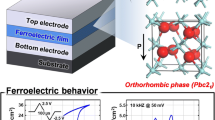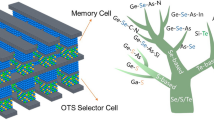Abstract
Gallium doped ZnO (GZO) top electrode thickness dependence of resistive switching characteristic of GZO/ZnO2/ZnO/ITO transparent valence change memory device is investigated. The thickness of the GZO top electrode modulates the resistance of the pristine device. Devices made with thicker GZO layer have higher leakage current; thus, require higher current compliance. An excessively high current compliance leads to a device breakdown upon reset process. Conversely, a very low current compliance may form a tiny conducting filament and is difficult to rejuvenate after the rupture; thus, its cycle-to-cycle characteristic shows a decaying behavior. Nevertheless, transparent valence change devices with a stable endurance and sufficient memory window that operate at a moderate level of current compliance are successfully fabricated by employing an appropriate thickness of the top electrode. We suggest that a good switch-ability of transparent valence change memory devices are strongly affected by the thickness of the top electrode.




Similar content being viewed by others
References
T.Y. Tseng, S.M. Sze, Nonvolatile memories materials, devices and applications, vol 1 (American Scientific Publishers, CA. USA, 2012)
F.M. Simanjuntak, T. Ohno, S. Samukawa, ACS Appl. Electron. Mater. 1(1), 18–24 (2019)
J.J. Yang, D.B. Strukov, D.R. Stewart, Nat. Nanotechnol. 8, 13 (2012)
R. Aluguri, D. Kumar, F.M. Simanjuntak, T.-Y. Tseng, AIP Adv. 7(9), 095118 (2017)
H. Akinaga, H. Shima, Proc. IEEE 98(12), 2237–2251 (2010)
S. Chandrasekaran, F.M. Simanjuntak, D. Panda, T.-Y. Tseng, IEEE Trans. Electron Devices 1 (2019)
T.-C. Chang, K.-C. Chang, T.-M. Tsai, T.-J. Chu, S.M. Sze, Mater. Today 19(5), 254–264 (2016)
S. Chandrasekaran, F.M. Simanjuntak, R. Aluguri, T. Tseng, Thin Solid Films 660, 777–781 (2018)
D. Panda, T.-Y. Tseng, J. Mater. Sci. 48(20), 6849–6877 (2013)
F.M. Simanjuntak, P. Singh, S. Chandrasekaran, F.J. Lumbantoruan, C.-C. Yang, C.-J. Huang, C.-C. Lin, T.-Y. Tseng, Semicond. Sci. Technol. 32(12), 124003 (2017)
P. Singh, F.M. Simanjuntak, A. Kumar, T. Tseng, Thin Solid Films 660, 828–833 (2018)
F.M. Simanjuntak, B. Pattanayak, C.-C. Lin, T.-Y. Tseng, ECS Trans. 77(4), 155–160 (2017)
Q.L. Gu, C.C. Ling, X.D. Chen, C.K. Cheng, A.M.C. Ng, C.D. Beling, S. Fung, A.B. Djurišić, L.W. Lu, G. Brauer, H.C. Ong, Appl. Phys. Lett. 90(12), 122101 (2007)
H.-Y. Lee, C.-T. Su, B.-K. Wu, W.-L. Xu, Y.-J. Lin, M.-Y. Chern, Jpn. J. Appl. Phys. 50(8), 088004 (2011)
F.M. Simanjuntak, S. Chandrasekaran, B. Pattanayak, C.-C. Lin, T.-Y. Tseng, Nanotechnology 28, 38LT02 (2017)
F.M. Simanjuntak, S. Chandrasekaran, C.-C. Lin, T.-Y. Tseng, Nanoscale Res. Lett. 13(1), 327 (2018)
F.M. Simanjuntak, S. Chandrasekaran, C. Lin, T.-Y. Tseng, APL Mater. 7(5), 051108 (2019)
Y.H. Kang, J.-H. Choi, T. Il Lee, W. Lee, J.-M. Myoung, Solid State Commun. 151(23), 1739–1742 (2011)
F.M. Simanjuntak, T. Ohno, S. Samukawa, AIP Adv. 9(10), 105216 (2019)
F.M. Simanjuntak, T. Ohno, S. Samukawa, ACS Appl. Electron. Mater. 1(11), 2184–2189 (2019)
C.-W. Zhong, W.-H. Tzeng, K.-C. Liu, H.-C. Lin, K.-M. Chang, Y.-C. Chan, C.-C. Kuo, P.-S. Chen, H.-Y. Lee, F. Chen, M.-J. Tsai, Surf. Coatings Technol. 231, 563–566 (2013)
S.-Y. Wang, D.-Y. Lee, T.-Y. Tseng, C.-Y. Lin, Appl. Phys. Lett. 95(11), 112904 (2009)
S.Z. Rahaman, Y. De Lin, H.Y. Lee, Y.S. Chen, P.S. Chen, W.S. Chen, C.H. Hsu, K.H. Tsai, M.J. Tsai, P.H. Wang, Langmuir 33(19), 4654–4665 (2017)
M.J. Wang, F. Zeng, S. Gao, C. Song, F. Pan, J. Alloys Compd. 667, 219–224 (2016)
D. Panda, F.M. Simanjuntak, T.-Y. Tseng, AIP Adv. 6(7), 075314 (2016)
S. Chandrasekaran, F.M. Simanjuntak, T. Tseng, Jpn. J. Appl. Phys. 57, 04FE10 (2018)
F. Chiu, Adv. Mater. Sci. Eng. 2014, 1 (2014)
M.-C. Jun, S.-U. Park, J.-H. Koh, Nanoscale Res. Lett. 7(1), 639 (2012)
F.M. Simanjuntak, D. Panda, T.-L. Tsai, C.-A. Lin, K.-H. Wei, T.-Y. Tseng, J. Mater. Sci. 50(21), 6961–6969 (2015)
F.M. Simanjuntak, D. Panda, T.-L. Tsai, C.-A. Lin, K.-H. Wei, T.-Y. Tseng, Appl. Phys. Lett. 107(3), 033505 (2015)
Q. Mao, Z. Ji, J. Xi, J. Phys. D. Appl. Phys. 43(39), 395104 (2010)
K.M. Kim, T.H. Park, C.S. Hwang, Sci. Rep. 5, 1 (2015)
Acknowledgments
This work was supported by the Ministry of Science and Technology, Taiwan, under project MOST 105-2811-E-259-002. D. Panda acknowledges to the DST-SERB, Govt. of India research grant to support (Grant no: SRG/2019/000129) for this work.
Author information
Authors and Affiliations
Corresponding authors
Ethics declarations
Conflict of interest
The authors declare no conflict of interest.
Additional information
Publisher’s note
Springer Nature remains neutral with regard to jurisdictional claims in published maps and institutional affiliations.
Rights and permissions
About this article
Cite this article
Simanjuntak, F.M., Panda, D., Chandrasekaran, S. et al. Evaluating gallium-doped ZnO top electrode thickness for achieving a good switch-ability in ZnO2/ZnO bilayer transparent valence change memory. J Electroceram 46, 14–19 (2021). https://doi.org/10.1007/s10832-021-00239-6
Received:
Accepted:
Published:
Issue Date:
DOI: https://doi.org/10.1007/s10832-021-00239-6




